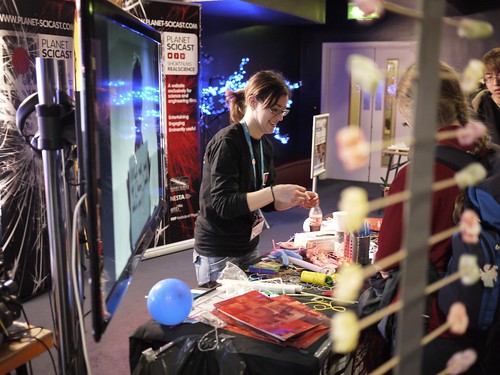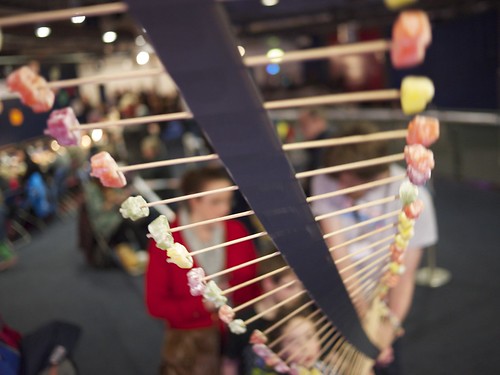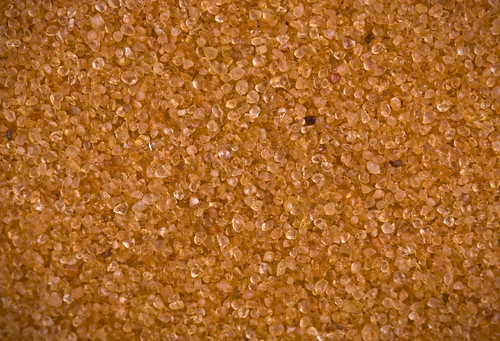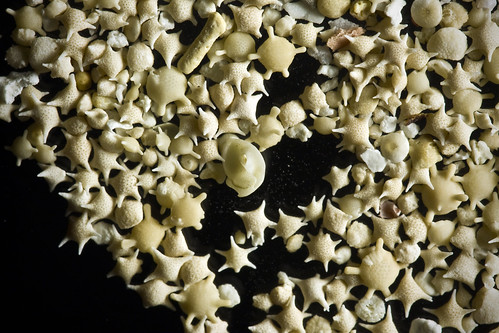Jonathan: March 2011 Archives
Maker Faire UK is huge, ridiculous, messy, and glorious. It’s almost the opposite of the corporate polish of the Big Bang Fair, with exhibitors from all walks of life showing off things they’ve made — which could be anything from knitted neurons to tiny rollercoasters for ball-bearings to radio-control daleks (one wearing a fez and a rather dapper bow tie) to bits of electronics to… films.
Yes, SciCast was there, showcasing the films you’ve made over the years and introducing the project to scores of families. We were mostly doing the spinning straws trick, and got through more than 2,000 straws over the weekend. That’s a lot of snipping, bending, and blowing.
Huge fun, and we hope to see lots of films from families in this year’s competition.
Just before the doors opened on Sunday morning we knocked up a quick jelly baby wave machine, which miraculously survived the day. Lots of teachers and home-schoolers seemed very taken with it — if you’d like to know more, see the old SciCast film about it, or this more recent film we made for teachers.
Thanks to everyone who dropped by the stand over the weekend, it was lovely to meet you all.
The coming weekend sees the return of Maker Faire to Newcastle. SciCast will be there running a stand, making films and trying not to trip people up with tripods and lighting stands, but last weekend we filmed another group’s preparations:
Too much fun. Click through to the film at Vimeo or this subtitled version.
Of course, in our book cardboard and wood are engineering materials. While this particular film is rather too long to count for SciCast (not to mention that entering our own competition is probably against the rules, or something), we’d just love it if someone submitted a film of a game like this.
Meanwhile: see you in Newcastle this weekend?
One of the things I never managed to bring into the How2 studio was a rubber-powered free-flight model aeroplane. They’re amazing things: gossamer-light, profoundly fragile, yet flying slower than seems remotely possible.
Float is a documentary film that’s in production, but while we’re waiting for it — grab yourself some plans, make a simplified version of one of these models, and put together a SciCast film of your triumphs and disasters. There might be other plans out there too — I found the ones at that link after just a few minutes’ Googling.
Jaded old coot that I am, I don’t often see demonstrations that are new to me. So this film has made my day. Things I think could be better:
- Clamp or at least brace a (probably rather slow) power drill. I think the movement of the centre of rotation rather spoils the effect, or at least clouds the argument.
- A long-exposure photograph should show very lovely trails, which might make it easier to see that the sparks are moving radially (plus or minus a little momentum as they’re ejected from the sparkler). Even better if you can arrange everything vertically.
Sounds like a wonderful idea for a beautiful and useful SciCast film. We’re too good to you.
Obviously: burning things, so schools will want to complete a risk assessment and at home you’ll want to keep anything flammable well away, even with ‘indoor’ sparklers. Eye protection would be a good idea. Think carefully about other things we may not have caught here.
I’ll confess, I never thought of ‘sand collecting’ as being a thing until now. Apparently people do it. Who knew?
However, there’s something rather beautiful about this collection of photographs of sand. We don’t get many geology or earth science films for SciCast, and there’s clearly some interest to be had in exploring the world around you in close-up detail. You may not have a proper macro lens for your camera, but it’s surprising what you can achieve filming through a magnifying glass or a photographer’s loupe. Here’s a picture I took with one of those and a really rubbish old mobile phone camera:
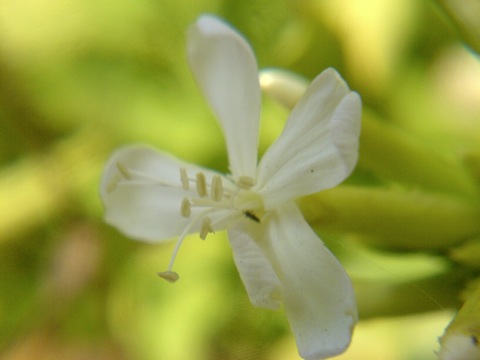
Could be worse, right?
What can you tell us about sand formation, or different types of soil or rock, or plant reproduction, using these sorts of detail shots?
I can’t wrap up this post without one more picture, though: star sand. Who knew this stuff existed? Click through for notes from the photographer.
(sand photos by Flickr user Mouser Williams, published under CC BY-NC-SA.)
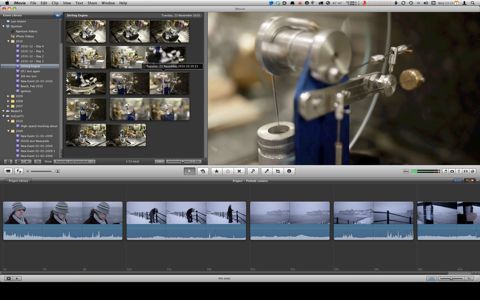
If you’ve read the appropriate bits of Film School, you’ll know that we’re big fans of iMovie. It’s terrific editing software, and the biggest problem is that you need a Mac to run it. Later this month, however, the somewhat anaemic iPhone/iPod touch/iPad version of iMovie is seeing a huge update, and from the snippets we’ve been shown so far it looks just as wondrous as its desktop counterpart.
We’ll do our best to find out just how good the camera in the new iPad 2 is — if it’s anywhere near the standard of a Flip or (still our favourite!) Kodak Zi8, it’ll be hard to beat. The ability to shoot, edit, and upload a film all from one device is pretty much the goal here, and it looks like we might finally have got there.
The BBC’s College of Production is terrific and all, but it’s a bit… well, it’s a bit straight-laced BBC, isn’t it?
This isn’t. At all:
The whole of Vimeo Video School is a little crazy, but sometimes that’s a good thing, right? Right?
I’ve been watching some of the BBC’s College of Production material, looking for things that might be useful for SciCast film-makers. It’s a bit tricky to ferret out, though, as they’re still struggling a little with what tone and level to pick — their films tend to use quite proper jargon, but cover material that you probably know already if you understand the language they’re using. Odd.
I did like this, however, which illustrates a range of angles that you might take of, say, somebody doing an experiment on a lab bench:
Ignore any bits of the voice-over that don’t make sense, and have a think about how working like this might affect the film you’re making. Chances are you don’t need to get this technical for SciCast, but sometimes knowing what’s possible and how to think can either solve a problem for you, or add that little extra something that lifts your film above the competition.

